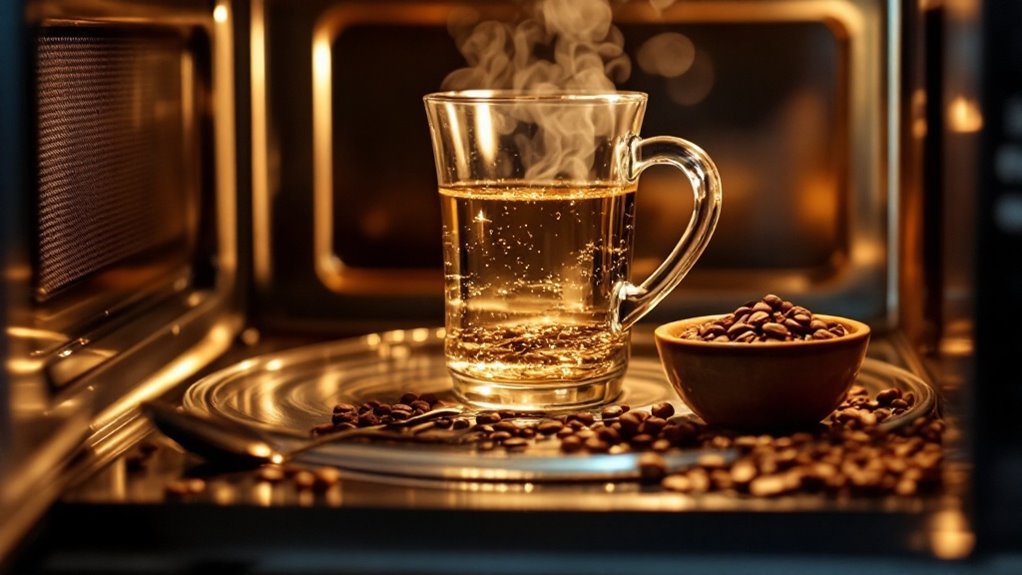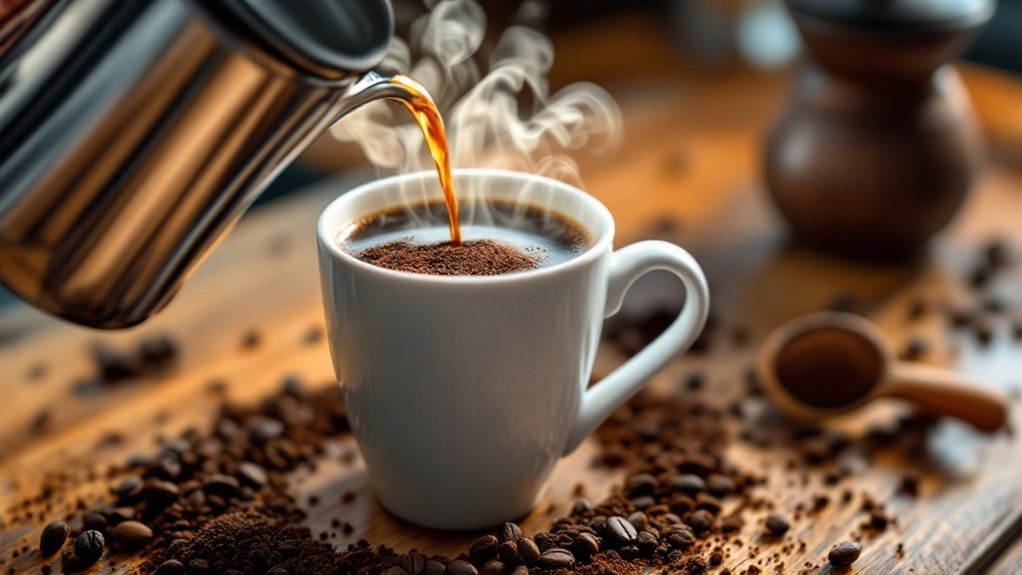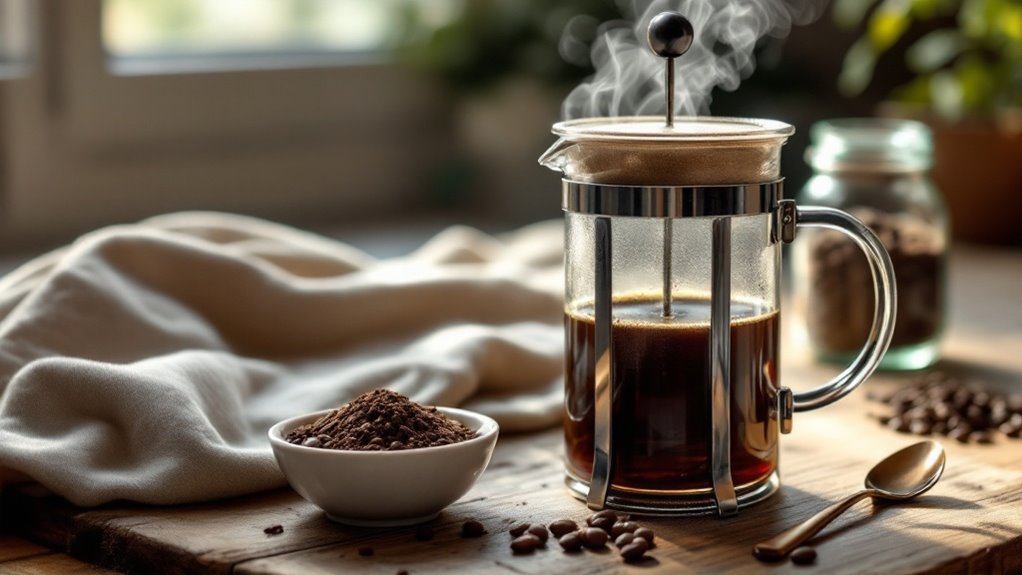







You might not realize that the grind size of your coffee beans can substantially impact the strength of your brew, even more than the amount of grounds you use. If your coffee tastes too strong, try adjusting the coffee-to-water ratio or shortening the brewing time to avoid over-extraction. But what if these changes don't give you the milder flavor you're after? There's a simple yet often overlooked method that can transform your cup without sacrificing quality—and it doesn't involve throwing out your favorite beans. The key lies in understanding how small tweaks can make a big difference.
Key Takeaways
- Adjust the coffee-to-water ratio to 1:16 (e.g., 25g coffee to 400g water) for a milder brew.
- Use coarser grind sizes to reduce extraction and create a smoother, less intense flavor.
- Shorten brewing time to prevent over-extraction; steep French press for 2 minutes or drip coffee for under 5 minutes.
- Dilute brewed coffee with hot or cold water post-brewing to weaken its strength.
- Use light-roasted beans for a cleaner, less bitter flavor profile compared to dark roasts.
Adjust the Coffee-to-Water Ratio
To make your coffee weaker, start by adjusting the coffee-to-water ratio. The ratio determines the strength of your brew, so increasing the amount of water or decreasing the amount of coffee grounds will dilute the flavor. A standard ratio is 1-2 tablespoons of coffee per 6 ounces of water. For a milder cup, reduce the amount of coffee grounds or increase the amount of water. For example, if you're brewing drip coffee, try using 7 ounces of water per cup instead of the typical 5-6 ounces. This simple adjustment guarantees a lighter, less intense brew without changing your brewing method.
If you're making cold brew, aim for a ratio of 1.5 cups of water per ounce of coffee grounds. This creates a milder concentrate that you can dilute further with water or milk when serving. Always measure your coffee and water precisely to maintain consistency. Use a kitchen scale or measuring tools to confirm accuracy. By mastering the coffee-to-water ratio, you'll have full control over the strength of your coffee, making it as weak or strong as you prefer. Adjusting the ratio is the easiest way to fine-tune your brew without needing new equipment or techniques.
Use Light-Roasted Coffee Beans
If you're aiming for a milder cup of coffee, switching to light-roasted beans can make a noticeable difference. Light-roasted coffee beans are roasted for a shorter time, which preserves their natural acidity and bright, fruity or floral notes. This roast level results in a brewed coffee that tastes less intense and bitter compared to darker roasts. Since light roasts have less oil on the surface, they produce a cleaner, more delicate flavor profile, ideal for weaker coffee. When selecting beans, opt for varieties like Kona or Ethiopian, which are known for their lighter, more nuanced characteristics. Keep in mind that while light roasts may contain slightly more caffeine, their flavor is perceived as milder due to the lower concentration of roasted compounds. To maximize the effect, pair light-roasted beans with a balanced brewing method, such as pour-over or drip coffee, which highlights their subtle flavors. By choosing light-roasted coffee beans, you can achieve a smoother, less robust cup that suits your preference for a gentler brew.
Modify the Grind Size
To make your coffee weaker, use a coarser grind size, as it reduces surface area and limits extraction, resulting in a milder flavor. Match the grind size to your brewing method—coarser grinds work well for French press or drip coffee, while finer grinds are better for espresso or pour-over. Adjusting your grinder to a coarser setting will help balance strength and reduce bitterness in your cup.
Coarse Grinds Reduce Strength
When aiming for a weaker coffee, adjusting your grind size to a coarser setting can make a significant difference. Coarse grinds allow water to flow through the coffee bed more quickly, reducing extraction time and resulting in a milder brew. For a French press, use a grind size similar to sea salt; this decreases the surface area exposed to water, limiting the extraction of oils and solubles that contribute to strength. If you're using a drip coffee maker, opt for a coarser grind to prevent over-extraction, which can lead to a smoother, less intense cup. In pour-over methods, a coarser grind guarantees water passes through the grounds faster, producing a lighter and less concentrated brew. Always match your grind size to your brewing method—coarse grinds work best for immersion or slower extraction techniques. Experiment with your grinder settings, starting with a medium-coarse grind and adjusting coarser until you achieve the desired strength. Remember, the goal is to balance extraction time and flavor, so monitor your results and tweak as needed.
Fine Grinds Limit Extraction
Fine grinds, with their increased surface area, can lead to over-extraction and a stronger, more bitter coffee. To achieve a weaker extraction, you'll need to adjust your grind size. Fine grinds expose more coffee particles to water, intensifying the flavor and strength. If your coffee tastes too strong or bitter, switch to coarser grinds. Coarser grinds reduce the surface area, slowing down extraction and producing a milder, less intense brew. For methods like French press or cold brew, use a coarser grind setting on your grinder to guarantee a balanced, weaker extraction. Espresso, which relies on fine grinds for its concentrated strength, isn't ideal if you're aiming for a weaker cup. Instead, opt for coarser grinds suited to methods that naturally yield a lighter flavor profile. Experiment with your grinder's settings, moving incrementally toward a coarser grind until you achieve the desired strength. Remember, grind size directly impacts extraction, so small adjustments can make a big difference. By using coarser grinds, you'll limit over-extraction and create a smoother, weaker coffee tailored to your taste.
Adjust Grind for Brew Method
Adjusting your grind size based on your brew method is key to achieving a weaker coffee. Start by making your grounds coarser to reduce extraction and create a milder flavor. For a French press, use coarsely ground coffee to limit the contact time between water and grounds, resulting in a less intense brew. If you're using an AeroPress, switch from a fine to a medium grind to decrease the coffee's strength. For drip coffee, go slightly coarser than your usual grind to weaken the brew by lowering extraction efficiency. In pour-over methods, a coarser grind allows water to flow faster, leading to under-extraction and a lighter taste. When making cold brew, opt for coarsely ground coffee to produce a smoother, less concentrated result compared to finer grinds. Always match your grind size to your brewing process to control the strength of your coffee effectively. Experiment with coarser settings until you achieve the desired balance of flavor and intensity.
Reduce the Amount of Coffee Grounds
Use 1-2 tablespoons of coffee grounds per 6 ounces of water instead of the standard 2 tablespoons to weaken your brew. Decrease the coffee grounds by half or a full scoop to dilute the flavor and reduce intensity. Adjust your coffee-to-water ratio to 1:16 for a milder cup with less oil and flavor extraction.
Decrease Coffee Ground Quantity
To weaken your coffee, start by reducing the amount of coffee grounds you use per cup. For a standard 8-ounce cup, decrease the grams of coffee from 10-15 grams to 5-7 grams. This adjustment lowers the ratio of coffee to water, creating a milder brew. If you typically use 2 tablespoons of grounds, try cutting it to 1 tablespoon. Reducing the coffee grounds by 25-50% noticeably weakens the strength while keeping the drink enjoyable.
Experiment with incremental changes, like removing 1/4 scoop of grounds at a time, to find your preferred level of weakness. Pay attention to the coffee-to-water ratio; fewer grounds mean less extraction, resulting in a lighter flavor profile. For example, if you're brewing a full pot, reduce the total amount of grounds proportionally. Keep in mind that using fewer grounds also lowers caffeine concentration, which may be desirable if you're sensitive to caffeine. Always measure your grounds consistently to maintain control over the strength of your coffee.
Adjust Brew Ratio for Weakness
The brew ratio is your key to crafting a milder cup of coffee. To weaken your brew, reduce the amount of coffee grounds while keeping the water volume constant. Start by using 1-1.5 tablespoons of coffee per 6 ounces of water, which lowers the ratio of dissolved coffee in your cup. For a standard weaker brew, aim for a 1:16 ratio—one part coffee to 16 parts water—or higher. This adjustment dilutes the flavor, making it less intense than stronger coffee. If you're using a scale, measure 10-12 grams of coffee per 200 ml of water instead of the typical 15-18 grams. This method guarantees a lighter, more balanced taste without altering brewing time or grind size. Remember, the fewer grounds you use, the weaker your coffee becomes. Experiment with ratios to find the perfect balance for your palate. Keep in mind that consistency is key—measure your coffee and water each time to maintain the desired strength. By tweaking the brew ratio, you'll achieve a milder cup every time.
Measure Coffee for Desired Strength
Measuring coffee for a weaker brew starts with reducing the amount of grounds while keeping your water volume steady. To achieve a milder cup, adjust your coffee-to-water ratio. For standard brewing, use 1-2 tablespoons of coffee grounds per 6 ounces of water. To make weaker coffee, reduce this to 1 tablespoon per 8 ounces of water. Alternatively, cut the amount of coffee grounds by 1/2 or 1 full scoop per brew to dilute the flavor. If you're weighing your coffee, aim for 10-12 grams of coffee per 200 ml of water instead of the standard 15-18 grams. For a lighter brew, try a 1:16 coffee-to-water ratio, such as 25g of coffee to 400g of water. Keep your brewing time consistent to avoid over-extraction, which can make weak coffee taste bitter. Use the same amount of time and water in your coffee maker, but simply reduce the coffee grounds. This guarantees a balanced, weaker coffee without altering the brewing process. Adjust gradually to find your preferred strength.
Shorten the Brewing Time
Shortening the brewing time is one of the simplest ways to make your coffee weaker. By reducing the brewing time, you extract fewer dissolved solids, resulting in a milder and less intense cup. For a French press, steep your coffee grounds for just 2 minutes instead of the usual 4 minutes. This shorter steeping time limits the extraction of bitter compounds, producing a smoother, weaker coffee. If you're using drip coffee makers, aim for a brewing time of less than 5 minutes. Over-extraction occurs when water passes through the grounds too slowly, so a faster brew guarantees a lighter flavor. For cold brew, steep your coffee for 8 hours instead of the standard 12 hours. This reduces the concentration of dissolved solids, yielding a less robust and more approachable brew. Adjusting the brewing time is a precise method to control the strength of your coffee without altering the coffee-to-water ratio. Experiment with shorter times to find the perfect balance for your taste.
Dilute With Water After Brewing
Dilution offers a straightforward solution for adjusting coffee strength after it's brewed. To weaken coffee, simply dilute with water post-brewing. Start by pouring your brewed coffee into a cup, then add hot water gradually. A 1:1 ratio of coffee to water is a good starting point, but adjust to taste—more water for a milder flavor, less for a bolder one. This method preserves the original extraction while reducing overall strength.
You can use either hot or cold water, depending on your preference. Hot water works well for maintaining temperature, especially if you're making Americanos, which are fundamentally espresso shots diluted with hot water. Cold water is ideal for iced coffee or when you want to cool your drink quickly.
Dilution is a quick fix that doesn't require changing your brewing process or grind size. It's perfect for rescuing over-extracted or overly strong brewed coffee. Experiment with ratios to find your ideal balance, ensuring a consistent, enjoyable cup every time. This technique is simple, effective, and keeps your coffee routine flexible.
Avoid High Water Temperatures
To achieve a weaker cup of coffee, you can intentionally lower the water temperature during brewing. The brewing temperature plays a vital role in how strong or weak your coffee is made. When water is one of the main factors in extraction, using cooler water slows down the process, resulting in fewer coffee solids dissolving into your cup. Make sure to aim for a temperature below 195°F to under-extract the grounds, which naturally weakens the brew. If you're using a kettle, let the water cool for a minute or two after boiling before pouring it over the coffee. Use filtered water to guarantee a clean taste, as impurities can affect the overall flavor. Next time you brew, experiment with slightly cooler water to find the right balance for your preference. This method avoids the bitterness that comes with overly hot water, which can over-extract and intensify the coffee's strength. By controlling the temperature, you'll create a milder, smoother cup that's perfect for those who prefer a lighter coffee experience.
Use Stale or Pre-Ground Coffee
One simple way to make your coffee weaker is by using stale or pre-ground coffee. When roasted coffee beans sit for more than 8 days, they lose up to 70% of their flavor, resulting in a milder brew. If you're using pre-ground coffee, the larger surface area of the grounds speeds up oxidation, further reducing the intensity of the coffee you're using. This makes it an ideal choice if you're aiming for a less robust cup.
To achieve this at home, avoid grinding fresh beans and opt for pre-ground coffee instead. If you've had a bag of grounds sitting in your pantry for a while, that's perfect—stale coffee naturally weakens over time. You can also purchase pre-ground coffee from coffee shops, which often sits longer than freshly roasted beans.
When brewing, stick to your usual method, but expect a lighter flavor profile. This approach is especially helpful if you're sensitive to strong coffee or prefer a gentler taste. Just remember, the older the grounds, the weaker your coffee will be.
Disclosure: As an Amazon Associate, I earn from qualifying purchases.






